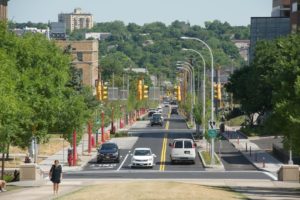Keeping yourself safe as you walk around campus can be as simple as turning off your music or waiting just a few more seconds at an intersection to let a car cross safely in front of you.
The Department of Public Safety would like to remind the University community of a few easy steps that everyone can take to ensure we all reach our destinations unharmed:
- Avoid wearing earbuds or headphones. Most of the time, you don’t even think about it: walking across the Quad or back home from class, you turn on your iPod and pop your earbuds in before you’ve even gone ten steps. But listening to music deprives you of some of your awareness of your surroundings. You may not be able to hear a car approaching or another pedestrian’s warning shout.
- A couple recent studies have drawn attention to the dangers associated with listening to headphones while walking around traffic: From the University of Maryland, From Consumer Reports
- Wait for the walk signal! Don’t think you can make it across the street before a car can. Sometimes it can be hard to judge the speed of an oncoming car, and sometimes the driver is not paying as much attention as they should be. Solve all of these potential problems at once and wait for the green light.
- Be proactive: Wear light or reflective clothing during low-light situations. Stay out of the driver’s blind spot.
- Look both ways before crossing and cross at the crosswalk: There’s a reason your parents drilled these rules into your brain at age two: they are the most basic and most essential rules of being a good pedestrian.

- Know how to contact us: If something should happen to you, or if you witness an accident on campus, call DPS right away at 315.443.2224. If there’s an emergency and you cannot make a phone call, text us at 711@syr.edu. Program both our phone number and text address into your phone. You can also use the LiveSafe app to report any incidents.
Have a concern related to pedestrian safety? Submit your concern via our pedestrian and bicycle safety request for action form.
Though these guidelines seem like common sense, following them can drastically increase your personal safety.
For additional information, check out the National Highway Traffic Safety Administration or our Traffic on Campus Page.
